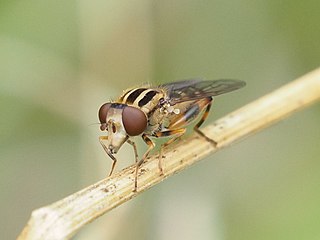
Lejops is a genus of hoverflies, closely related to the genera Helophilus, Quichuana and Mallota.

Pterallastes is a genus of bee-mimicking hoverflies. So far the genus contains only two species, one in North America and one from the Sichuan province of China.

Teuchocnemus is a genus of North American flower flies.

'Brachyopa notata , the Black-banded Sapeater , is a rare species of syrphid fly. It has been observed in Northeastern North America. Hoverflies get their names from the ability to remain nearly motionless while in flight. The adults are also known as flower flies for they are commonly found around and on flowers from which they get both energy-giving nectar and protein rich pollen. Larvae for this genus are of the rat-tailed type. B.notata larvae have not been described.

Somula is a genus of syrphid flies in the family Syrphidae. There are at least two described species in Somula.
Brachyopa gigas (Lovett, 1882), the Giant Sapeater, is a rare, species of syrphid fly. It has been observed in Washington state and California. Hoverflies get their names from the ability to remain nearly motionless while in flight The adults are known as flower flies for they are commonly found around and on flowers from which they get both energy-giving nectar and protein-rich pollen. Larvae for this genus are of the rat-tailed type. B.gigas larvae have not been described.

Anasimyia perfidiosus is a species of syrphid fly in the family Syrphidae, found in North America.
Lejota is a genus of syrphid flies in the family Syrphidae.

Asemosyrphus polygrammus, the common sickleleg, is a species of rat-tail maggot fly in the family Syrphidae.

Chalcosyrphus depressus the Wide-eyed Leafwalker, is a rare species of syrphid fly observed from Idaho and Montana. Hoverflies can remain nearly motionless in flight. The adults are also known as flower flies for they are commonly found on flowers, from which they get both energy-giving nectar and protein-rich pollen.
Brachyopa perplexa , The Hairy-striped Sapeater, is an uncommon species of syrphid fly. It has been observed from the Appalachian Mountains to New York and Quebec, Canada. Hoverflies get their names from the ability to remain nearly motionless while in flight. The adults are also known as flower flies, for they are commonly found around and on flowers, from which they get both energy-giving nectar and protein-rich pollen. Larvae for this genus are of the rat-tailed type. B.perplexa larvae have not been described.
Sphegina rufa is a species of hoverfly in the family Syrphidae.

Sphegina infuscata is a species of hoverfly in the family Syrphidae.

Brachyopa media ( Williston, 1882), is a rare species of syrphid fly. It has been observed in the Northeastern United States. Hoverflies get their names from the ability to remain nearly motionless while in flight. The adults are also known as flower flies for they are commonly found around and on flowers from which they get both energy-giving nectar and protein-rich pollen. Larvae for this genus are of the rat-tailed type. B.media larvae have not been described.
Brachyopa rufiabdominalis , the Red-tailed Sapeater, is a rare species of syrphid fly. It has been observed in Colorado. Hoverflies get their names from the ability to remain nearly motionless while in flight. The adults are also known as flower flies, for they are commonly found around and on flowers from which they get both energy-giving nectar and protein-rich pollen. Larvae for this genus are of the rat-tailed type. B.rufiabdominalis larvae have not been described.
Arctosyrphus is a genus of rat-tail maggot flies in the family Syrphidae. This genus has a single species, Arctosyrphus willingii. It was formerly a member of the genus Lejops.

Asemosyrphus is a genus of rat-tail maggot flies in the family Syrphidae. There are three described species in Asemosyrphus. They were formerly members of the genus Lejops.

Eurimyia is a genus of rat-tail maggot flies in the family Syrphidae. There are three described species in Eurimyia. They were formerly members of the genus Lejops.
Lunomyia is a genus of rat-tail maggot flies in the family Syrphidae. This genus has a single species, Lunomyia cooleyi. It was formerly a member of the genus Lejops.
Epistrophella is a genus of hoverflies in the subfamily Syrphinae, formerly treated as a subgenus of Epistrophe.











